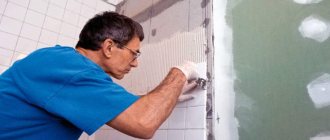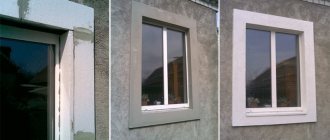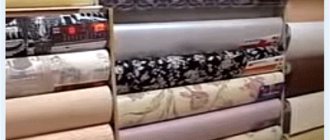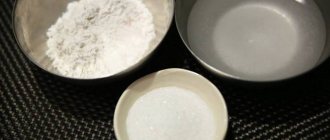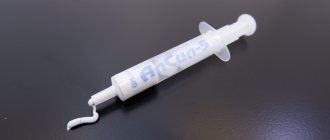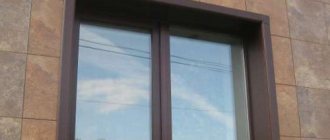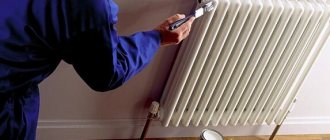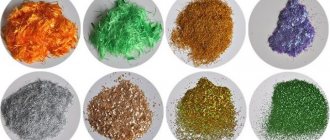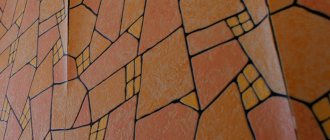Advantages of adhesive pipe joints
Polymer pipes are welded, glued or mechanically connected to each other. The first method is the most popular. For welding, special equipment and nozzles selected according to the diameter of the pipeline are used.
It is better to entrust such work to professional craftsmen. The option is to rent or buy your own device. It's expensive, but it will help you learn another useful skill.
The glue connection method is less common, but no less effective. It is commonly called “cold welding”. Adhesive seams are just as (and sometimes even more) reliable as welded ones. The only caveat: almost all types of adhesives for plastic pipes are designed for cold water supply systems and can quickly lose their properties when exposed to high temperatures.
Advantages of gluing PVC pipes using special compositions:
- Reducing the risk of leaks. When gluing sections of pipeline, the parts are connected at the molecular level. The seams are absolutely sealed, and they can only begin to leak under the influence of high temperature or pressure.
- Minimum labor costs. Gluing pipes does not require any additional complex processes. This is a simple method that does not require special skills.
- Fast and cheap installation. All operations can be performed with your own hands. You just need to buy the materials and choose the right adhesive composition. No need to look for a welding machine.
- Low energy consumption. The machine for welding polymer pipes runs on electricity, and no equipment is required for gluing parts. This is additional savings on materials and energy resources.
- Versatility. The method is suitable for connecting pipeline parts of any diameter - from 6 to 400 mm. It can be used when installing water supply and sewer systems.
Cold welding is a cheap and convenient way to install a pipeline. To use it, you do not need anything that could lead to an increase in the cost of work: you do not have to spend money on additional connecting elements or special equipment.
The principle of operation of all types of adhesives for polypropylene pipes is approximately the same. The compositions partially dissolve polyvinyl chloride and firmly bind the particles. The compositions contain additives that improve adhesion. When gluing, the solvent quickly evaporates, and the composition hardens and gains strength. The result is a high-strength connection.
On the market you can find products for creating high-strength joints from both foreign and domestic manufacturers.
Review of the best brands
In all ratings of adhesives for PVC pipes, the leading brands are Tangit (Germany), Genova (USA), Griffon (Netherlands), Gebsoplast (France). Buyers speak well of the adhesives “Phoenix”, “Vinilit”, “Mars” and others, but they are not so in demand and popular.
All types of adhesives for polymer pipes operate on the same principle, are available in packages of various sizes, and the appropriate composition should be selected depending on the purpose and technical characteristics.
Manufacturers' recommendations come first
When working with adhesives, you should always read the manufacturers' recommendations. Many compounds cannot be left open for more than a few minutes, because... they set quickly, making their further use difficult. The average time during which the glue can remain open is 4-5 minutes.
When purchasing a specific brand of glue, you should pay attention to its preparation for use. Some types are easy enough to mix, but two-component compositions have to be combined correctly and their consistency must be monitored. There is a risk of incorrect mixing, which leads to loss or change in adhesive properties.
Color and viscosity matter. Experienced plumbers prefer compositions of medium viscosity. They are easy to apply, and when joining parts, such glue does not spread, so you do not have to remove it with napkins. As for color, the colorless composition is suitable for white and colored pipes. It is not visible, even if the drops protrude beyond the glued area and freeze.
Adhesive for polypropylene pipes
The technology for gluing this type of material is practically no different from joining PVC pipes. Adhesives for polypropylene can be similar. Masters often use Tangit. This brand sells a number of one-component products that simply need to be applied to the surface of the pipe. Two-component products are also sold that must be mixed before use. They are more reliable, create the strongest seam, but require more effort to work. Here is a list of other good adhesives for polypropylene products:
- Cosmoplast 500. One-component transparent adhesive, used in everyday life and industry. The quality of adhesion to the surface is ideal, so the elements can even be placed at an angle (adhesive is shown for corners and pipe joints). One of the disadvantages is the very fast initial setting - 3-5 seconds. Complete polymerization occurs in 16 hours.
- Dow Corning 7091. It is an adhesive-sealant; the connection it creates will be resistant to water and temperature changes.
- WEICON Easy-Mix PE-PP. A two-component composition for all types of plastic pipes, the product is based on methyl acrylic. It hardens within a day, the initial setting occurs in 30 seconds.
The algorithm for gluing polypropylene pipes is similar to that for PVC products. First, the pipes are cut, then a test connection is made, and then gluing is carried out. After an hour, you can check the joint for leaks - this will allow you to immediately find the hole, repair it in time and avoid pipe leaks in the future.
Sometimes a leak occurs in a water supply system or drain pipes made of metal-plastic. It must be said that such cases are quite rare, because the strength of the material is very high. Why might holes form? The aluminum pipe, which is the base, can leak only if there are installation errors or if there is a serious mechanical impact on the product. Usually the reason is failure to comply with the bend radius during installation, then a hole is formed at the bend site. An incorrectly installed fitting can also cause the problem.
When making repairs, you first need to turn off the water and apply a temporary measure - apply a special adhesive tape or make a so-called pipe bandage from a piece of rubber. How to seal a metal-plastic pipe? If the hole is small, you can seal it with epoxy or caulk. The surface must first be treated with sandpaper and degreased. Sandpaper will create the desired roughness, which will enhance adhesion. Apply a layer of glue, then wrap the joint area with a bandage in 3-4 layers, smear it with another layer of glue. After 12 hours the pipe can be used.
If the leak occurs due to damage to the fitting, you need to turn off the water and disassemble the leaking end (remove the nut, pull out the pipe). It is important to inspect the O-ring, fitting, and threads for damage and replace the parts. If the pipe bursts, you will have to completely replace it.
We recommend: What glue is best to use for decoupage?
Criteria for choosing pipes and type of glue
When purchasing pipes and fittings, pay attention to the purpose of the products, diameter, and wall thickness of the products. The brand is of fundamental importance. A good brand is not only money invested in advertising, but also real quality, thanks to which the product does not lose its position in the market. It is always better to choose reliable manufacturers, even if their products are a little more expensive than unknown analogues.
When choosing components, it is worth reading the technical documentation, which indicates the purpose of the product, the temperature conditions at which it remains functional, the safety margin and service life, and the manufacturer’s warranty.
You should carefully examine the pipes and fittings. Their internal and external surfaces must be smooth, and their structure must be uniform, without signs of delamination, streaks, cracks or other defects.
When purchasing glue, consider not only the characteristics of the composition itself, but also the following nuances:
- Pipeline installation location . Working conditions in different areas can be very different in terms of the degree of contamination, the temperature of the liquid in the pipes or the environment, and other important parameters. It is possible that adhesive compositions will have to be selected separately for different zones.
- Fluid pressure. All manufacturers make sure that there are no unnecessary claims against them from customers, so they must indicate what pressure the pipe glued with their compound can withstand. The higher this characteristic, the more reliable and expensive the glue. Saving is irrational.
- Features of loads . Often, pipelines can move due to mechanical stress from the outside or due to pressure from the inside. If severe shear loads are possible at the joint, a more durable adhesive should be selected.
- Temperature regime . Some types of adhesives are excellent for arranging a cold water system, but will be ineffective for a sewer pipeline, because... the temperature of the wastewater is different.
When choosing an adhesive, it is important to take into account the characteristics of the compositions. They usually contain volatile toxic substances. People prone to allergies are better off not working with toxins: they will either have to entrust the installation of the pipeline to specialists, or choose another method of connecting parts.
Pipes, fittings, and adhesives should only be purchased at specialized retail outlets. You should not save money by choosing “the same” products on a spontaneous market. Popular products are often counterfeited, so it is better to contact sellers with a good reputation who monitor the reliability of their suppliers and are ready to provide guarantees or exchange low-quality goods.
The nuances of choosing the right type of glue
When purchasing a product, it is important to understand not only its characteristics, but also the following important points:
- Place of attachment. Working conditions can vary greatly, for example, according to the purpose of the polyvinyl chloride pipe, its contamination and the temperature of the water that will pass through it. It is possible that different adhesive compositions will be required for some fastening areas;
- Fluid pressure. Typically, manufacturers indicate on the packaging the pressure that a given product can withstand, and the higher this indicator, the higher the cost of the product.
- Loads. Links may shift due to mechanical stress. You can eliminate such problems by choosing glue for PVC pipes of high cost and from a trusted manufacturer.
- Temperature. It is necessary to read on the packaging what type of water supply it is suitable for, since some mixtures are used for cold water supply, but do not seal the sewer pipeline; the temperature regime is different there.
- Read the composition of the glue. Most mixtures contain toxic volatile substances, so allergy sufferers should not carry out the installation themselves, but entrust this task to specialists.
Step-by-step instructions for using the composition
Before you start gluing plastic pipes, you should make sure that there is normal air circulation in the room and the temperature is between 5-35 degrees. In addition to materials, the work will require some tools:
- for marking - marker and measuring tools;
- for cutting pipes - pipe cutters, jigsaw or hacksaw;
- for cleaning surfaces - sandpaper;
- for degreasing – solvent;
- to apply the composition - the glue itself, a brush made of natural bristles (some glues, including Tangit, are immediately equipped with a suitable brush) or a glue gun.
Surface preparation is an extremely important stage in gluing parts. They should be perfectly smooth and fat-free. If contaminants remain on the pipe, the glue will only stick on top of them and form a film, but there will be poor contact with the surface itself. This may cause leaks to develop over time.
Pipeline bonding technology:
- Pipe marking . Before starting the installation of the pipeline, a design and detailed diagram must be prepared. The pipes are measured and marked using them.
- Cutting pipes . The next stage is preparing sections of the required length. It is best to use pipe cutters, but other tools will work. The main thing is that the cutting areas are level. The edges are cleaned with sandpaper.
- Bonding system elements . The most convenient way is a glue gun. With its help, you can evenly and accurately distribute the composition over the surface. If you don't have a gun, you should use a brush. The glue is applied so that in the selected area there are no areas free from it.
- Connecting parts . To connect, the system elements are pressed against each other for at least 20-30 seconds. During this time, the composition thickens and becomes more viscous. Then the part can be put aside for a day. It is important that the compression force is sufficient, otherwise the joint may leak during operation.
- Pipe cleaning . No matter how carefully the glue is applied, it may extend beyond the intended area. It is removed immediately before it hardens. A damp cloth, rag or sponge is suitable for this.
- Polymerization of the composition . It takes 20-24 hours for the glue to harden, so it is better not to touch the system before. You cannot move, separate or reconnect parts, or run water through pipes.
When the glue polymerization process is complete, you should check the efficiency of the system. It is launched in operating mode and all joints are carefully examined. If it doesn't leak anywhere, everything is fine. If leaks are detected, the connections are additionally sealed.
An important nuance: when gluing parts you need to work extremely clearly. The pipeline section is inserted into the fitting in one motion. It should not be sharp, but fast. When the pipe is inserted, it should not be wiggled or twisted so as not to reduce the strength of the connection.
Detailed master class on pipeline installation using the “cold welding” method
When installing PVC pipes, you must follow certain step-by-step instructions:
- Before starting work, you should make sure that the room temperature is in the range from 5 to 30 degrees and there is constant air circulation.
- Prepare the appropriate tools: marker, ruler, pipe cutter, jigsaw, sandpaper, degreasing solvent, natural bristle brush, adhesive composition itself.
- Prepare your work surface. It is necessary to clean the parts, wash them and degrease them. If the pipeline is dirty, the glue will adhere only to the top and form a film; contact with the pipe will be unreliable and superficial, which will lead to leakage.
- Carry out markings. Before starting work, prepare a project and a pipeline gluing diagram. Afterwards the parts are marked and measured.
- Cut pieces of the required length using pipe cutters or a jigsaw. Make sure that the cut areas are even and smooth. Clean them with sandpaper.
- Glue the elements of the water supply system using a special mounting gun, evenly distributing the adhesive composition over the surface and leaving no gaps or empty areas. If you don’t have a gun, then a regular paint brush will do.
- Keep the links together for about 30 seconds, during which time the mixture will become viscous and dense. It is better to leave the links connected together for a day.
- If glue leaks beyond the surface, it must be cleaned up. It is ideal to remove it immediately with a damp cloth or cloth before it hardens.
- The coupling takes place within a day, so until this time the fastened links cannot be touched, otherwise everything can be displaced. As soon as the time period has passed, be sure to check the system and inspect the joints for leaks.
Useful video on the topic
Using cold welding, truly high-quality water and sewer pipelines are assembled. Moreover, the method can be used equally effectively when laying communications in a private and multi-storey building.
If you don’t have confidence in your own abilities, it makes sense to hire professionals. But home owners who know how to use tools will not have any difficulty completing the work themselves. We offer useful video materials to help craftsmen.
Why is it better to glue PVC pipes? An experienced master answers:
How and with what you can cut polymer pipes is described in the following video:
The ideal choice is a multi-tool that cuts pipes smoothly and immediately chamfers:
The choice of glue directly depends on the type of pipes, so you should pay attention to them:
There is no simpler technology for connecting polymer pipes than gluing. The method is cheap, convenient, and is not inferior in efficiency to welding. Almost anyone can install a pipeline using glue, because... he will not need any special skills.
The main thing is to choose the right pipes, glue and tools, and be careful and careful when working.
sovet-ingenera.com
Technical characteristics of PVC products
PVC (polyvinyl chloride) is a polymer that is an environmentally friendly material, has a low melting point and is susceptible to low temperatures. These two somewhat negative properties are offset by the durability and high strength of the material.
The physical properties of the polymer give PVC pipes the following qualities:
- High ring stiffness. The pipes are resistant to water hammer and are able to maintain pressure in the system up to 120 atmospheres.
- Do not deform when exposed to high temperatures. During heating to the maximum permissible temperatures, the pipes increase by only 5%.
- Low heat resistance. The rigidity of the adhesive PVC pipe is lost when the temperature reaches 78 ºC. In this regard, the use of such pipes in pipeline systems where the water temperature may exceed 40 ºC is not permitted.
- Instability to low temperatures. Polyvinyl chloride is able to function down to -15 ºC. At lower temperatures the material begins to deteriorate. Therefore, if the main line is laid in cold regions, then it needs additional insulation.
The operational properties of the pipes will be as follows:
- Long operating time without interfering with the system for cleaning purposes. Siltation is minimized due to the very smooth inner walls.
- It is the best solution for the construction of sewer systems. Preference is given to these pipes, again, due to the smooth internal walls and their small thickness.
- Long service life. In particular, this is achieved due to the material’s resistance to ultraviolet radiation.
Adhesive installation of polyvinyl chloride pipes
Glue for PVC pipes and fittings is also called cold welding, and not by chance, because it distributes the load, which increases strength and extends the service life of the pipeline to the same extent as it ensures the connection of elements by real welding. PVC pipe adhesive creates a polymer splitting reaction in solvents. After the pipe walls have softened, a fitting with softened walls is attached to them. This process is also called chemical welding.
In this case, it is worth considering one feature. Due to the fact that the chemical properties of additives and solvents vary, the choice of adhesive for PVC pipes must be made taking into account the thermoplastic compounds being welded. As a rule, companies producing plastic pipes offer instructions on the optimal solution to this issue. Be that as it may, it is worth remembering that when joining parts made of chlorinated polyvinyl chloride (CPVC) and regular PVC, you need to use different brands of glue.
The use of glue for PVC sewer pipes is considered a fairly popular method, which ensures excellent tightness of the finished structure.
Remember that uneven coating of pipes with glue or the presence of a large number of irregularities can cause partial glue failure. Complete non-gluing may also occur - this happens when both layers of glue dry out. Please note that you only have a few minutes to complete the connection operation.
The appearance of a soft adhesive layer is caused by a low ambient temperature or by allowing a small amount of time for hardening.
The layer may become porous - this happens when the adhesive layer is enriched with air due to poor mixing of the components.
Method of gluing PVC pipes
This technique creates a beautiful monolith of parts. Masters of their craft call the process “cold” welding.
Note! The gluing method is not recommended for hot water supply.
PVC operating principle and properties
Adhesive for PVC pipes and fittings is two-component. Additives are used to ensure good binding, control of viscosity and adhesion.
The glue contains solvents, they interact with the material, the plastic becomes viscous. The viscous composition of the parts is mixed. During the drying and hardening process, a molecular bond is formed. The result is a monolithic pipe.
Buying glue for PVC. What to pay attention to
- For what purposes is the composition used?
- Properties of glue.
- Setting time.
Under normal conditions, it is no more than four minutes. At elevated temperatures it is reduced to one minute.
- Composition color
- Density
- Glue viscosity
- How to store it correctly
Note! One manufacturer can produce several types of glue. With different setting speeds. From 4 minutes to 10 minutes.
All this can be found out by reading the manufacturer's label.
Experts prefer colorless glue of medium viscosity.
Advantages of cold welding
- Low risk of leaks
- Completely sealed
- Simple installation process
- Easy to glue pipes yourself
- The method is suitable for connecting cold water and sewer mains
- Low costs
IMPORTANT!!! For gluing pipes, it is better to use glue from well-known manufacturers that have proven themselves in the market.
Pipe cold welding adhesive has two categories
- For connecting pipes and fittings with a gap of less than 0.1 mm - does not fill gaps.
- For installation with a gap of up to 0.8 mm - gap filling.
Types of glue for PVC
Griffon
- Griffon (Griffon) made in Holland
- Griffon (Griffon) WDF-5 - for flexible pipes. Manufacturer Netherlands
- Griffon (Griffon) UNI-100 – for rigid PVC. Manufacturer: Holland.
Other
- Tangit glue (Tangit) manufacturer Germany
- Gebsoplast (Gepsoplast) is manufactured in France
- Genova (Genova) made in USA
- Phoenix
- Vinylite
- Mars
Tips for choosing adhesive
There are other brands, but they are not in demand on the market and therefore raise doubts.
Tangit composition is one that does not fill gaps.
Griffon UNI-100 – filling gaps.
When purchasing glue, carefully read the manufacturer's recommendations. For which pipes is the composition intended? Whether the glue fills gaps or not. Setting time.
Types of adhesives and installation methods
All chemical compositions for plastic pipes with glue belong to two groups.
The first group includes hot fusion adhesives for sewer pipes. In addition, they are suitable for connecting both air and water pipes made of PVC. When used correctly, the adhesive composition results in a high-quality and durable connection. For this, instructions from the manufacturer are included - they will allow you to use the substance correctly, so that the joints will be completely sealed.
Please note that glue for PVC sewer plastic pipes is a flammable substance. Therefore, adhere to all fire safety rules. Also, avoid contact with skin!
The connection of pipes, even in the case of not very clear processing of the seams, will have a high-quality result. For installation you will need a special soldering iron for plastic products. It is enough to acquire ordinary small-sized non-professional equipment.
A soldering iron will be needed to heat the ends of the pipeline elements. As a rule, the device is equipped with a number of different attachments that allow you to work with pipes of different sections. The tool consists of heating elements and a sole. To properly solder pipes, you need to study all temperature conditions of the tool. In this case, all parts of the water supply system will need to be heated to 260 ºС.
Another welding method is cold gluing.
In this case, gluing PVC pipes will be carried out by the following means:
- universal;
- specialized.
The difference between them is that the second option can only be used for gluing pipe products, while the first can be used for any products consisting of polyvinyl chloride. For example, universal cold welding glue is suitable for soldering linoleum.
Laying PVC pipes using cold welding is most often done using the socket method. Before use, the glue must be mixed thoroughly. To obtain a better quality connection, the narrow part of the pipe surface is made slightly rough at the factory. During installation, the inside of the socket must be degreased, after which the pipe is coated with an adhesive composition and chemical welding is used.
It is especially worthwhile to treat the surfaces for gluing with high quality - they should be as clean as possible (about
Types of glue
- One-component, ready to use.
- Two-component, providing for pre-mixing of compositions with different properties. They are characterized by increased strength and long shelf life. Disadvantage: longer installation.
Depending on the consistency, adhesives for PVC pipes are divided into liquid, semi-liquid, and thick. When selecting a composition with a suitable viscosity, it is necessary to proceed from the required solidification rate and the temperature range in which the system is operated. Thick adhesives are easier to work with and are better suited for installers with little experience.
We recommend giving preference to adhesive compositions from proven foreign and Russian manufacturers. Such products have undergone extensive testing and are successfully used at the most critical facilities: from industrial enterprises to the largest shopping and office centers.
Tips for choosing adhesive for PVC pipes
When choosing what to glue PVC pipes with, be sure to read the instructions and also take into account the properties of the material.
The following parameters are considered the most important:
- Connection type – cold or hot. These concepts have been described above.
- Freezing time. For cold welding, this period is 4 minutes at room temperature, and about 1 minute at temperatures above 40 ºC. For hot welding, the indicators will be as follows: hardening time - about half an hour; hardening – 150 minutes; final polymerization – 24 hours.
- Method of application and correct storage. If you neglect this point, the adhesive properties of the material will significantly deteriorate.
On the glue package you can see data on a list of characteristics, such as viscosity, color and density. Given the fact that PVC pipes can be soft, hard or corrugated, some manufacturers divide adhesives into certain types.
There are two types:
- For products made of soft materials. These include corrugated pipes and water supply pipes.
- For hard products. This includes siphons, fittings, and so on.
Regardless of how hard the material is, the newest adhesives easily cope with exposure to both cold and hot water. When choosing such products, try to buy products from well-known manufacturers. Actually, we’ll talk about them below.
Types of glue for PVC pipes
Depending on the principle of action of the adhesive composition, glue for PVC pipes is divided into two groups:
- for hot glue connection,
- for cold adhesive joints.
In the first case, the connection occurs after preheating. For installation, a special soldering machine is required, not necessarily a professional one; even a small device can provide a tight connection due to the action of the adhesive composition, which is applied in accordance with the instructions.
Note! Even a low-quality seam, thanks to the glue, creates a strong and tight adhesion. But an important condition for an effective connection is the temperature regime. Heating should not be less than 260°C.
Cold adhesive joints are called cold welding. For this method, universal or special adhesive compositions are used, which differ from each other in that the former are used for all types of PVC products, not just pipes, and the latter are made specifically for the installation of pipelines.
We recommend that you read: Technological features of welding galvanized pipes
Cold welding is carried out using the socket method: after applying glue to the surface of the pipe, the parts are connected and held motionless for some time.
It is important! With this method, one of the key stages is the pre-treatment of the ends of the elements being connected: they must be cleaned of dirt and degreased. If foreign particles remain at the bonding site, the strength of the connection is significantly reduced.
Well-known manufacturers of adhesives for PVC pipes
Any adhesive for this type of pipe consists of a certain amount of polyvinyl chloride dissolved in tetrahydrofuran and other similar substances.
The most common and high-quality brands include:
- TANGIT . Country of manufacture: Germany. Can be used to connect polyvinyl chloride pipes in water supply systems. This glue provides high-quality gluing, the resulting joints are durable. The glue is easy and simple to use. The jar comes with brushes. The products are accompanied by certificates indicating that the glue can be used in systems with drinking water supply.
- MARS . Manufactured in Russia. The adhesive composition is based on compounds of synthetic resins together with organic solvents. This adhesive is suitable for joining pipes and other elements made of polyvinyl chloride. The advantages include the high adhesiveness of the substance, as well as the quality of the connection, the strength of which is excellent.
In addition to these brands, experts also recommend adhesives of such brands as “Phoenix” and “Vinilit”. They also provide a reliable connection as good as the brands described above.
Above we described how to seal a PVC pipe and how to do it correctly. We hope everyone was able to obtain the necessary information for themselves.
trubaspec.com
Review of the best brands
The adhesive used for PVC water supply pipes consists of tetrahydrofuran. The most famous and popular manufacturers:
- TANGIT is manufactured in Germany. The adhesion of all plastic links, thanks to this glue, is durable and very strong, and it is also easy to use. The kit includes a brush, the product has a quality certificate that allows it to be used in cold water systems used to supply drinking water.
- MARS is produced in Russia, it contains a synthetic resin and an organic solvent. The glue very reliably seals the joint.
The list of popular brands includes: Phoenix and Vinilite.
Plastic pipes for gluing
PVC water pipes are made by extrusion from polyvinyl chloride, a thermoplastic polymer with a limited operating temperature. PVC is one of the cheapest plastic materials to produce, which results in a low cost of the final products.
There are two types of polyvinyl chloride pipes, differing in technical characteristics - products made from regular PVC and CPVC (chlorinated):
- PVC pipes are used for the installation of cold water supply systems, sewerage (pressure and free-pressure) and drainage systems; they can also be used as casing pipes when drilling water wells. The maximum operating temperature is +40 degrees;
- CPVC pipes have greater heat resistance (working temperature maximum +900), they can be used in hot water supply systems and heating communications (radiator heating, heated floors).
CPVC, and any other polymer products, can be connected in three ways:
- using fittings;
- using soldering (high temperature welding);
- using gluing (cold welding).
Joining by soldering and adhesive joints are non-separable - after joining, a monolithic structure is formed, while pipelines connected by fittings (threaded and compression) must be dismantled. However, it is worth considering that a monolithic joint is much more reliable, it reduces the risk of system leaks to zero, and according to the technology used, adhesive joining of plastic pipes is the simplest and fastest installation method.
Using adhesive joints, water pipes and heating communications of the following types can be assembled:
- polyethylene (PE, HDPE, LDPE);
- polypropylene (PN);
- metal-plastic (PEX, PE-RT).
Performance characteristics of CPVC pipes
CPVC pipes are the optimal choice when installing water supply, heating and sewerage systems based on the totality of their operational characteristics. The advantages of these products are:
- high mechanical strength and resistance to deformation (tensile strength of CPVC is 80 mPa, elastic modulus is 2500 mPa);
- possibility of use in pressure pipelines (they are available in three modifications - PN10, 16 and 25, designed for the appropriate pressure);
- minimal linear expansion when heated (does not exceed 0.6 mm/m);
- ideally smooth internal walls (roughness coefficient 0.6), on which no foreign formations appear, which guarantees the preservation of the original hydraulic characteristics throughout the entire life of the pipeline;
- complete resistance to corrosion and chemically aggressive substances, due to which a long service life of 50 years is achieved.
CPVC pipes are available in a diameter range of 16-225 mm, SDR (diameter to wall thickness ratio) can vary from 6-41. The ring stiffness directly depends on the SDR parameter - how much pressure the pipeline can withstand without undergoing deformation.
Choosing glue for PVC pipes
Adhesive compositions used for joining plastic pipes by cold welding are divided into two groups:
- adhesives that do not fill gaps - used in cases where the gap between the pipe and the adapter (fitting) is less than 0.1 mm;
- Gap-filling adhesives - used when there is a gap of up to 0.8 mm.
Gaps of up to 0.1 mm are observed during the installation of internal water supply and heating systems, which use pipes and fittings of small diameters (up to 40 mm); gaps of up to 0.8 mm occur when connecting sewer systems and external water pipelines, where products of large diameters are joined using sockets.
The best option for a non-filling composition is Tangit glue. This is a two-component adhesive based on UPVC polymer and tetrahydrofuran, which can be used for the installation of pressure pipelines (transporting gas, among other things) from polypropylene, polyethylene and PVC pipes.
Tangit glue has a density of 0.097 g/ml and heat resistance similar to the heat resistance of PVC. The composition is resistant to chemically aggressive substances (solvents and inorganic acids). At room temperature (+200) the glue hardens within 4 minutes (at 400 - 1 min). Tangit is supplied in containers of 0.125, 0.25, 0.5 and 1 kg.
Regulatory document VSN No. 35-86 “Installation instructions for plastic pipelines” recommends using GIPC-127 grade composition as a filling adhesive. This glue can be used to connect cold water supply pipes (the heat resistance of the composition is 40 degrees).
The adhesive joint at a temperature of 200 has a strength of 5 MPa. The water supply pipeline, for the installation of which GIPC-127 glue was used, can be used 6 days after gluing; the system must first be flushed 10 times.
In general, an adhesive joint has high mechanical strength and a sufficient margin of safety only when installing water pipes for cold water; if you plan to install heating communications, it is better to join pipes by soldering, since any glue changes its technical characteristics when heated.
How to glue PVC pipes? (video)
trubypro.ru
Types of glue for polyethylene and polypropylene
Polypropylene is actively used in a variety of industries, for example, in medicine and food production, in the automotive industry, and high-tech industries. It is valued for its plasticity and ease of processing, because this material can take on any shape.
Polypropylene is sold, as a rule, in the form of granules of different colors, which are later used in industry. Product packaging, disposable syringes, car bumpers, pipes, films, film threads and much more are made from this material.
There are several types of polypropylene:
- isotactic – most commonly used in industry,
- atactic - characterized by a waxy and oily form,
- stereoblock,
- syndiotactic - have a viscous consistency.
In general, all types of polypropylene have the following properties:
- low density,
- strength,
- impact resistance,
- preservation of properties during repeated bending,
- low gas and vapor permeability,
- resistance to alkalis, salt solutions, acids, oils,
- water resistance,
- easy to recycle,
- not afraid of boiling.
Adhesives capable of holding plastic parts together can be divided into two groups:
- Thermosetting. They are based on epoxy, polyester and thermosetting resins.
- Thermoplastic. Adhesives in this group are divided into rubber-based mixtures and resin-based adhesives.
Thermoplastic adhesives for polypropylene soften and dissolve under the influence of temperatures. Thermosetting ones have a slight advantage, since they retain their structure unchanged.
An example of thermosetting adhesives is anaerobic adhesive for polypropylene, which begins to act when exposed to an accelerator, hardener or heat.
Anaerobic adhesive for polypropylene
Another classification of mixtures is into one- and two-component ones. The one-component ones are presented in a ready-to-use form; you just need to squeeze them out of the tube.
We recommend: How to work with Poxypol glue? Its advantages and disadvantages
This is, for example, transparent adhesive sealant for polypropylene Moment. Two-component ones include two components that must be mixed together before use.
An example is the one-component adhesive for polypropylene Cosmoplast 500; it is actively used in window production for gluing profiles.
As for two-component compositions, epoxy adhesive with a hardener and epoxy resin is popular here. It has a longer shelf life, since until the two components react, gluing will not occur.
Composition and principle of action of adhesive materials
You can seal a plastic sewer pipe using special adhesives for foam plastic.
PVC adhesive is a two-component adhesive for plastic.
Several additives are added to polypropylene adhesives, the use of which controls the time of formation of the viscosity of the adhesive solution.
The technology for gluing plastic tubes is that when the adhesive solution hardens, chains of PVC polymer molecules, which are located in the pipe elements being glued, intertwine.
The result is a pipe connection that has the same properties as an unbonded PVC pipe.
What to look for when buying PVC glue?
When purchasing glue for PVC pipes, you should study the information about its use indicated by the manufacturer on the tube or jar.
When gluing plastic pipes, you should buy time-tested brands of adhesive solutions - Tangit glue (Germany), Griffon (Holland), etc.
You also need to find out some useful properties of the adhesive solution - setting time of the glue, etc.
At a temperature of 18-25 degrees Celsius, the setting time of the adhesive solution is 4 minutes. When the temperature rises to 40 degrees Celsius, the setting time becomes 1 minute.
In addition to this parameter, the adhesive packaging indicates the color and density of the adhesive solution, the viscosity of the mixture, etc. In such a situation, you can find out how to use the adhesive solution and the storage conditions for the remaining adhesive.
The glue is applied in a thin layer to the parts to be glued only after degreasing
Choosing the type of glue
When installing thermal insulation in rooms, builders insulate not only the facade, but also the inside of the house. Therefore, polystyrene adhesive is made in 2 types - for interior and exterior use.
Adhesive for polystyrene foam for exterior use must have the following characteristics:
- strong adhesion to pipe sections;
- resistance to sudden temperature changes;
- should not contain harmful toxins in the adhesive composition;
- ease of use, etc.
Experienced installers choose those adhesive solutions that do not have special conditions of use.
One such solution is tangit glue, which is made in Germany:
Characteristics of the adhesive solution
Tangit glue for PVC pipes is used when joining pressure plastic pipes used to connect gas and water pipelines to the house.
Such an adhesive solution has the following advantages.
- reliably glues PVC pipes for a long time;
- The adhesive solution is easy to use - there are brushes in the glue jar;
- a similar adhesive for PVC plastic has been used in 120 countries for 30 years;
- after 4 minutes it glues PVC pipes for sewerage together, etc.
Indications for use:
- before applying glue to the tube, you need to clean the pipe surfaces from grease stains and dirt residues;
- Shake the tube of Tangit glue well;
- then you need to apply an even layer of adhesive solution: first inside the coupling, and then on the tube;
- Next, you should insert the tubular product into the coupling until it stops;
- Next, you need to firmly hold the pipe part for 30 seconds - 1 minute, until the glue dries;
- then remove excess adhesive solution with paper napkins.
The tubes must not be moved for 5 minutes after gluing. At temperatures equal to 10 degrees Celsius and below, the tube cannot be moved for 15 minutes.
In such a situation, filling the new piping system with water cannot begin earlier than 24 hours after the final pipe bonding.
When gluing a plastic pipeline, the elements must not be rotated or displaced.
Safe use and storage
When using tangit glue, you must follow these safety rules:
- tangit glue for PVC pipes, like other adhesive solutions, is highly flammable. This adhesive for polypropylene pipes should be used in a well-ventilated room;
- when using it, do not light a fire, smoke, turn on electrical equipment or do welding;
- when using Tangit adhesive solution, use protective gloves;
- you must not forget the tube or jar of glue after use;
- glue can only be stored in its original tube or jar, at a maximum temperature of 35 degrees Celsius;
- Do not throw any remaining glue down the drain.
When disposing of such an adhesive solution, remove the adhesive from the tube when it has dried.
How to calculate the consumption of adhesive composition
According to the installers, the consumption of the adhesive solution for polypropylene must be calculated at the point of use.
If you purchased a dry mixture, then the consumption of the adhesive solution is 500 g per 1 square meter. m of pipe surface.
When using a foam adhesive solution, the glue consumption will be as follows - 1 container per 6 square meters. m.
The specific amount of glue required depends on the material from which the tubes are made (polypropylene, polyethylene, etc.).
Characteristics of some types of glue for polypropylene pipes
Today there is a large selection of means that can be used to glue polypropylene and polyethylene. Let's take a closer look at the characteristics of some of them.
Cosmoplast 500
This is a one-component transparent adhesive composition that can be used for both domestic needs and in production. High adhesive properties make it possible to connect parts at an angle of 45 degrees, which has led to its popularity among masters producing plastic windows. It is distinguished by the short time required for drying: 3 seconds - initial setting and 16 hours - complete hardening (at a temperature of 20 degrees).
Dow Corning 7091
This one-component product is an adhesive-sealant type. If the thickness of the applied layer does not exceed 5 mm. then Dow Corning 7091 acts as an adhesive, and with a thickness of up to 25 mm – a sealant. This composition is best used for gluing homogeneous materials. The process of gluing polypropylene with this composition is not much different from other adhesives. The resulting seam is elastic, durable, oil- and moisture-resistant, and is also able to withstand temperature changes from -55 to 180 degrees Celsius.
WEICON Easy-Mix PE-PP
A universal two-component adhesive for polypropylene pipes will do an excellent job of joining polyethylene, polyamide, PVC, fiberglass and other materials and plastics. Created on the basis of methyl acrylic and has high adhesion. At room temperature it hardens completely after 24 hours.
This is, of course, not the entire list of PP adhesives on the market. And before gluing polypropylene, it is necessary to become more familiar with the features of adhesive compositions. This will eliminate possible errors that could lead to poor-quality gluing.
Polypropylene is a type of plastic that is difficult to glue together. Not so long ago, polypropylene adhesive began to be produced that can replace the “hot welding” joining method. The special glue made the work of the craftsmen easier, since there is no need to use special equipment that could cause injury, since the main focus is heating the material.
How to prepare and glue plastic pipeline elements
When gluing or soldering PVC pipe products, you should prepare them in advance.
The figure shows the stages of gluing pipe elements
Such work must be carried out in a dry room, the air temperature in which is +5 - +35 degrees Celsius.
To apply the adhesive solution, you need to use a brush made of natural bristles.
When gluing PVC pipe elements, you should perform the following steps:
- cut pipe sections with special pipe cutters. In such a situation, the tube will get an even cut - without the formation of sharp protrusions on the surface of the pipe.
If there is no pipe cutter, then cutting the pipe can be done using a saw with fine teeth;
- then you need to clean the edges of the cut with sandpaper to remove adhering dust, which interferes with obtaining a hermetically sealed connection of the tubes;
- then the entire pipeline system should be assembled. There is no need to apply glue to the tube. This must be done in order to make notches with a marker on all pipe gluing sections and determine the depth of the tubes entering the fittings;
- further, the assembled pipeline system should be disassembled and preparation of pipe elements for gluing should begin;
- Before applying glue for gluing plastic pipes, you should open the cleaner and remove greasy stains from the surface being used;
- then, the polyethylene glue is mixed;
- Next, you should apply a thin layer of adhesive solution with a brush onto the fitting sockets, and then onto the tube;
- then you need to insert the polypropylene tube into the fitting until it stops. In such a situation, under no circumstances should you touch the tube and other pipe elements connected during gluing - they must be in a stationary state.
In this case, you need to look at the marks that were made with a marker in advance. When gluing pipes, you must not turn or rotate the tube categorically.
At this stage of work, the pipe elements to be glued are held for 15 seconds, and the glue dries;
- Next, you should use a napkin to remove excess adhesive adhesive solution that has protruded along the edges of the pipe joint.
Do not move newly glued tubular products for 5–15 minutes.
Water can be poured into the resulting pipeline only after 24 hours have passed after the completion of joining the pipe elements with glue.
Please remember that polystyrene adhesive is highly flammable. It should be stored in a dark, dry place - away from rooms with open fire (gas stove, water heater, etc.).
Causes of defects when gluing PVC pipes
Uneven application of the adhesive solution and the formation of roughness on the pipe surface leads to partial non-gluing.
Complete non-gluing occurs only in a situation where the adhesive layers are completely dried out.
It should be remembered that you can glue PVC plastic for only 2 minutes, and then the glue dries.
The appearance of a soft layer of glue occurs due to low temperatures outside or due to insufficient time allotted for hardening of the adhesive solution.
The porosity of the adhesive layer appears when there is air in the layers of the adhesive solution, which penetrates into the mixture when the tube is gently shaken.
The distortion of the joining of tubes appears due to insufficient fixation of the connected pipe elements, as well as when they are displaced during the curing of the glue.
If there are residual dirt on the areas of pipes being glued together or if the pipe elements have not been treated with a cleaner, it is not possible to moisten the surfaces of the pipes with the adhesive solution.
As a result, in order to choose the right adhesive solution for connecting pipe elements, you should keep in mind such parameters as the type, thickness and other parameters of the material for thermal insulation.
It is also important to know the scope of application of the adhesive solution and the features of its operation.
By purchasing a specific adhesive solution, you can make reliable thermal insulation in the room.
You can assemble a pipeline system by hand - when arranging a summer house or constructing a sewer system in a house.
If you don’t have the skills and lack knowledge in this matter, then it’s better not to take risks, but to call professional installers to your home.
trubexpert.ru

